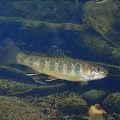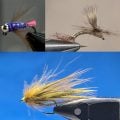How to Tie the F-Fly
Producer: Tim Flagler
After what seemed like an overly long winter, caddis fly season is finally in full swing here in New Jersey. Many early season caddis species appear to spend little time on the water’s surface as winged adults, and if they are on the water’s surface, their wings are generally in a more down position until they’re able to finally take flight. Trout recognize this and, as a result, lower riding imitations often work better than higher riding ones.
This is where Marjan Fratnik’s “F-Fly” comes in super handy, as its profile and the way it rides in the surface film are spot on. The F-Fly also happens to be rather simple to tie, and the colors of both the wing and the body are easily changed.
Here, I’m going to start an F-Fly on a Fulling Mill 5025, barbless hook in size 16. Begin by getting the hook firmly secured in the jaws of your tying vise.
For thread, I’ve loaded a bobbin with a spool of black UTC 70 Denier. Get the thread started on the hook shank, leaving a small space behind the eye then take a few wraps rearward before snipping off the excess tag.
The original pattern called for a thread body but I like to add just the smallest amount of natural-colored beaver fur. Pick out any of the longer guard hairs from the fine underfur. Using the underfur, build a short, very, very slender noodle on your tying thread. Start taking wraps with the noodle so the dubbing begins right at the start of the hook bend. Then take slightly overlapping wraps up the hook shank to create a thin body on the fly. Here, less is definitely better than more.
For the wings, I’ve selected two CDC feathers, not puffs, in a natural dun color. Place one feather on top of the other and do your best to keep their tips aligned. With the feathers in the fingers of your right hand, measure to form a wing that extends rearward to the back edge of the hook bend. Using a pinch wrap, lightly secure the CDC to the top of the hook shank, behind the eye. My wing’s a little long here so I’m going to pull on the butt ends to shorten it.
Once the wing is the correct length, take another thread wrap over top of the CDC to further lock it down, then pull the butt ends up and take two thread wraps beneath them, around just the hook shank, behind the eye. Follow these with two more tight wraps over top of the CDC. This wrapping sequence helps to ensure the CDC fibers won’t pull out or spin around the hook shank. You can then reach in with the tips of your tying scissors and snip the excess butt ends off close. Take a few thread wraps to sweep away any wayward fibers blocking the hook eye, then end with your tying thread at the base of the wing.
Pick up your whip finish tool and use it to do a 4 or 5 turn whip finish, seat the knot really well and snip or cut your tying thread free. To make sure nothing comes unraveled, apply a drop of head cement or here, Sally Hansen Hard as Nails, to the thread wraps behind the eye. It’s a good idea to use a fine-tipped bodkin to make sure the eye is clear of adhesive. Once the adhesive sinks in and dries, the F-Fly is ready to fish.
The wings help the fly to float and make it visible on the water’s surface, while the bottom profile remains nice and thin. When fished, an F-Fly usually rides about like this in the surface film and thus closely matches the orientation of the naturals.
How to Tie the Evil Olive
How to Tie the Fluff-Top Mayfly











